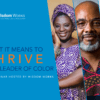We’re seated in a circle, amid concrete floors and a large gallery space which tends to echo sound. A diverse collection of local art hangs noiselessly on the walls. Sculptures perch silently on pedestals. The only sound carrying past our group is that of the cappuccino machine, which whirs and hums almost constantly. Art, caffeine, and conversation: It’s business as usual here at the Business of Art Center in the town of Manitou Springs.
Like the colorful assortment of art around us, we’re an eclectic group: some wearing workout clothes, others in business suits. We don’t really know each other, but have agreed to practice dialogue to address the following question:
What creates a healthy community?
This is our first and only meeting, and if all goes well, we should all learn something new from one another. As the facilitator, I’m just about to break the silence and begin the meeting, when a new batch of beans crunches through the cappuccino machine’s grinder. The sound seems to steal my thunder, but I clear my throat and kick off the meeting with a short excerpt from Peter Block. His words search for the foundations of true community, and this particular passage explores the concept of belonging. For Block, to belong is “to be related to and part of something … The opposite of belonging is to feel isolated and always on the margin, an outsider. To belong is to know, even in the middle of the night, that I am among friends.”
Incidentally, this very sentiment is emphasized by the New Economics Foundation. When commissioned by the UK government’s Foresight Project on Mental Capital and Well-being, the NEF reviewed the interdisciplinary work of over 400 scientists from across the globe. Out of the five key actions for creating vitality and well-being, “connect with people around you” was first on the list.
Our group is listening intently as I wrap up the short reading with Block’s explanation that “to belong to a community is to act as a creator and co-owner of that community … to seek in our communities a wider and deeper sense of emotional ownership.”
On the far side of our circle, a woman in yoga attire raises her hand. She’s a transplanted Australian named Del and she speaks up with her own definition. She feels that belonging is more about “longing to be,” using community to evolve ourselves individually. Through our personal growth, she explains, the community evolves in turn. I think to myself: “Cool, the conversation has begun.”
For the next hour the hum of our group trumps the cappuccino machine. We’re inquiring into each others’ perspectives, buzzing with new insights, building on ideas—and in the small spaces between each animated discussion, we’re reflecting on all that we’ve heard. Together we enter the question of how to build a healthy community, and the spirit of our conversation feels very right. It’s respectful, open, and non-judgmental. Near the end of our exchange, Becky—who sits near me wearing a high fashion suit—says: “Creating a healthy community is about what we’re doing now. We’re role modeling it.”
I agree. We’ve created the beginnings of a sense of belonging between us. There is already the “emotional ownership” that Block’s passage had described. I feel confident that the act of crafting a healthier future for our little community will be a bit easier because we are no longer strangers. Whether wearing yoga pants or dressy silk slacks, we’re people who care. We now know we matter to one another.
At the end of our meeting, the barista has finally cleared his line of customers. He leans on his counter watching our group with interest. The cappuccino machine sits silent, as if conceding the floor to our group’s excited hum.
Photo by DeaPeaJay





